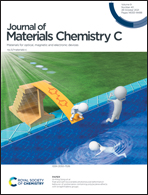Ferroelectric perovskite-enhanced photoelectrochemical immunoassay with the photoexcited charge-transfer of a built-in electric field†
Abstract
Efficient separation of photo-induced electrons and holes in the photoelectrochemical (PEC) sensors plays an important role in improving detection sensitivity. Based on this point, we report a simple and sensitive photoelectrochemical bioassay for prostate-specific antigen (PSA) detection using lanthanide-doped bismuth ferrite/reduced graphene oxide/tungsten oxide nanohybrids (BLFO/rGO/WO3) as the photo-sensing material. Initially, WO3 was excited under the continuous illumination to generate photo-induced electron–hole pairs. Then, rGO (as a suitable charge transfer medium) could effectively build a bridge between WO3 and BLFO. With the mediation of the built-in electric field in BLFO, the transferred charges were allowed for directional migration in the circuit, thus achieving an effective separation of the photogenerated electron–hole pairs. Coupling with the amplification of enzymatic production (H2O2) and specific recognition of antigen–antibody immunoreaction, target concentration was relative to the corresponding photocurrent, thereby realizing the PSA sensitive detection. Under optimal conditions, the PEC immunoassay exhibited a good linear relationship within a dynamic working range from 0.1 ng mL−1 to 200 ng mL−1 with a detection limit of 49.4 pg mL−1. In addition, this study afforded satisfying specificity, reproducibility, and long-term storage, which also matched well with the commercial PSA ELISA kit.



 Please wait while we load your content...
Please wait while we load your content...